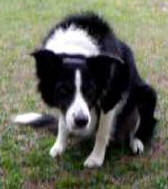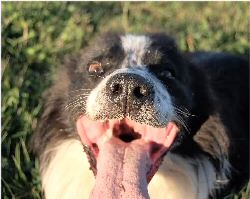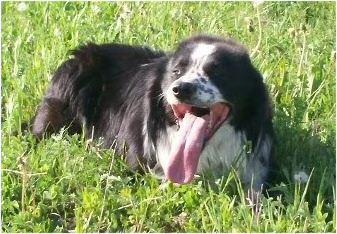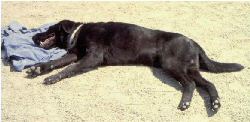Does your
dog suffer from the
collie wobbles?
 Border Collie Collapse (BCC) is an episodic nervous system disorder that
is triggered by strenuous exercise. It's been observed in dogs used for working stock as well as
dogs participating in agility or fly-ball competitions or repeatedly retrieving a ball. This
disorder has also been called exercise induced collapse (EIC), exercise induced hyperthermia (EIH),
stress seizures and 'the wobbles.' Research is currently underway to identify the
genetic mutation that characterises the disease. If you run a collie, you should be aware of
the symptoms. Dr Janette Mattey explains
more about it. Border Collie Collapse (BCC) is an episodic nervous system disorder that
is triggered by strenuous exercise. It's been observed in dogs used for working stock as well as
dogs participating in agility or fly-ball competitions or repeatedly retrieving a ball. This
disorder has also been called exercise induced collapse (EIC), exercise induced hyperthermia (EIH),
stress seizures and 'the wobbles.' Research is currently underway to identify the
genetic mutation that characterises the disease. If you run a collie, you should be aware of
the symptoms. Dr Janette Mattey explains
more about it.
Border Collie Collapse is a recognised
syndrome in Border Collies that has been described in the UK, USA and Australia. It has also
been called Exercise Induced Collapse, Exercise Induced Hyperthermia and Malignant
Hyperthermia, although Malignant Hyperthermia is a separate condition that occurs in Border
Collies as well as a number of other breeds.
It is a syndrome of hyperthermia and muscle and
organ damage that occurs with gaseous anaesthesia (halothane) and several other drugs on
occasion. It is a rare condition associated with a known genetic mutation, and a DNA test is
available for Malignant Hyperthermia.
BCC is usually seen in working
dogs or those training for high intensity activity such as agility or flyball, tending to
occur after 5 – 15 minutes of strenuous exercise. It may be, but does not have to be,
associated with high environmental temperature, and some have said that these dogs are prone to
high levels of stress or excitement.
Studies have been conducted and have not conclusively
shown there to be any predisposing factors, but owners and handlers of affected dogs have
tended to report that collapse occurs when their dogs are particularly excited, and possibly
happens more often in hot weather.
 What to look
for What to look
for
Affected dogs tend to develop a stiff,
stilted hind limb gait with a short stride, typical of muscle weakness, or they may just become
very wobbly in the hind limbs, and will then continue on to be unable to bear weight at all,
and collapse.
They may seem bright and alert mentally, however some do seem dull or confused. The rectal temperature will generally be very high, often over 41°C, but studies have shown
that it is not any higher than normal (unaffected) animals that are performing the same level
of strenuous activity.
Normal dogs develop
extremely high temperatures during strenuous exercise, but are able to reduce their
temperatures to within the normal range shortly after they stop exercising. Hence it is thought that the high temperature
seen in collapsed dogs is not part of the syndrome, but rather part of the normal rise that
occurs when performing these types of activities. Still, ensuring a dog suffering collapse can
cool off (e.g. put him in the shade), and ensuring access to fresh water (only if he is able to
drink), would certainly be beneficial in most situations.
Occasionally, deaths may occur during or
immediately following a collapse. It is, therefore, important that you stop your dog's activity
as soon as any sign of abnormal gait is seen, and allow the dog to recover quietly.
 Science Science
Signs of this syndrome are similar to
those seen in working Labradors with Exercise Induced Collapse (EIC), which has been well
studied. The genetic abnormality in Labradors has been determined, and was found to be due to a
mutation in the dynamin-1 gene. This mutation leads to defective communication between the
nerves and the muscles, so that in effect when the brain is telling the muscles to perform they
are unable to respond. This is generally seen in American lines of Labradors.Studies in Border Collies have shown
that affected dogs do not have the same dynamin-1 mutation as that which occurs in
Labradors with EIC. A study is currently underway by the same group of researchers who
determined the genetics associated with EIC in Labradors, testing a large number of samples
from both affected and normal Border Collies. It is hoped that they will discover the genetic
link to this disease, and be able to provide a DNA test for the condition, as they have done
for Labradors.
Border Collies that suffer from this
syndrome can generally live healthy lives, but will not be able to continue working (or
performing the activity that caused the episode of collapse). They should avoid all strenuous
exercise situations, and also avoid situations where they are likely to become overly excited. It is hoped that in the near future we will have further knowledge about the causes of this
condition, and hopefully with this will come advances to help prevent it in the future.
YouTube video
NEW DNA Testing Scheme
 At the request of the Labrador
Breed Council, the Kennel Club has recently approved a new official DNA testing scheme
for Exercise Induced Collapse (EIC) in the breed. At the request of the Labrador
Breed Council, the Kennel Club has recently approved a new official DNA testing scheme
for Exercise Induced Collapse (EIC) in the breed.
This test is offered in the UK by
Laboklin (www.laboklin.co.uk)
and in the US by Animal Genetics (www.animalgenetics.us),
and they can be contacted for further information via their websites.
As an agreement is already in
place with Laboklin to report other health test results, any EIC results will now
automatically be sent directly to the Kennel Club where the test result will be added to
the dog’s details on the registration database. This will trigger the publication of the
test result in the next available Breed Records Supplement, and the result will appear on
any new registration certificate issued for the dog and on the registration certificates
of any future progeny of the dog, and also on the Health Test Results finder on the
Kennel Club website.
However, the KC has no such
agreement with Animal Genetics and therefore if an owner has had their dog(s) tested
through this laboratory they will need to send copies of the test certificate into the
Kennel Club and the data will be added to the dog's registration details and the Health
Test Results Finder.
In addition, if the owner
includes the original registration certificate for the dog (not a copy) then a new
registration certificate will be issued, with the DNA result on it, free of
charge. Please send any DNA test certificates to:
 About
the author... About
the author...
Dr. Janette Mattey, BVSc, BAnSc, CMAVA (2011)graduated from the University of Melbourne in 1998 and spent a year studying
for her Bachelor of Animal Science, when she studied endocardiosis (degenerative mitral valve
disease) in dogs.
Since graduating,
Netty has worked in
emergency and critical care, both here in Melbourne and for a short period in Birmingham (UK). She has also done a little shelter work, and currently does some part-time work at a veterinary
pathology laboratory.
Netty
grew up on a farm in Northern Victoria with some cattle, chooks, a goat and an Airedale
Terrier. She also had a cat when I was nine, who died 10 years ago while she was working in the
UK. She currently has two cats - both boys - who keep jer company and sometimes try her
patience. She has have one who is quite well trained, and will sit, and fetch, and play 'paw
tennis.' The other is not so bright, and has not really learnt anything other than the word
dinner! She loves them both equally!
Netty is currently undertaking a
project to update their database at work on the current knowledge (by literature review) on the
50 – 100 most popular dog breeds in Australia and in the USA) and the inherited diseases they
are prone to.
|